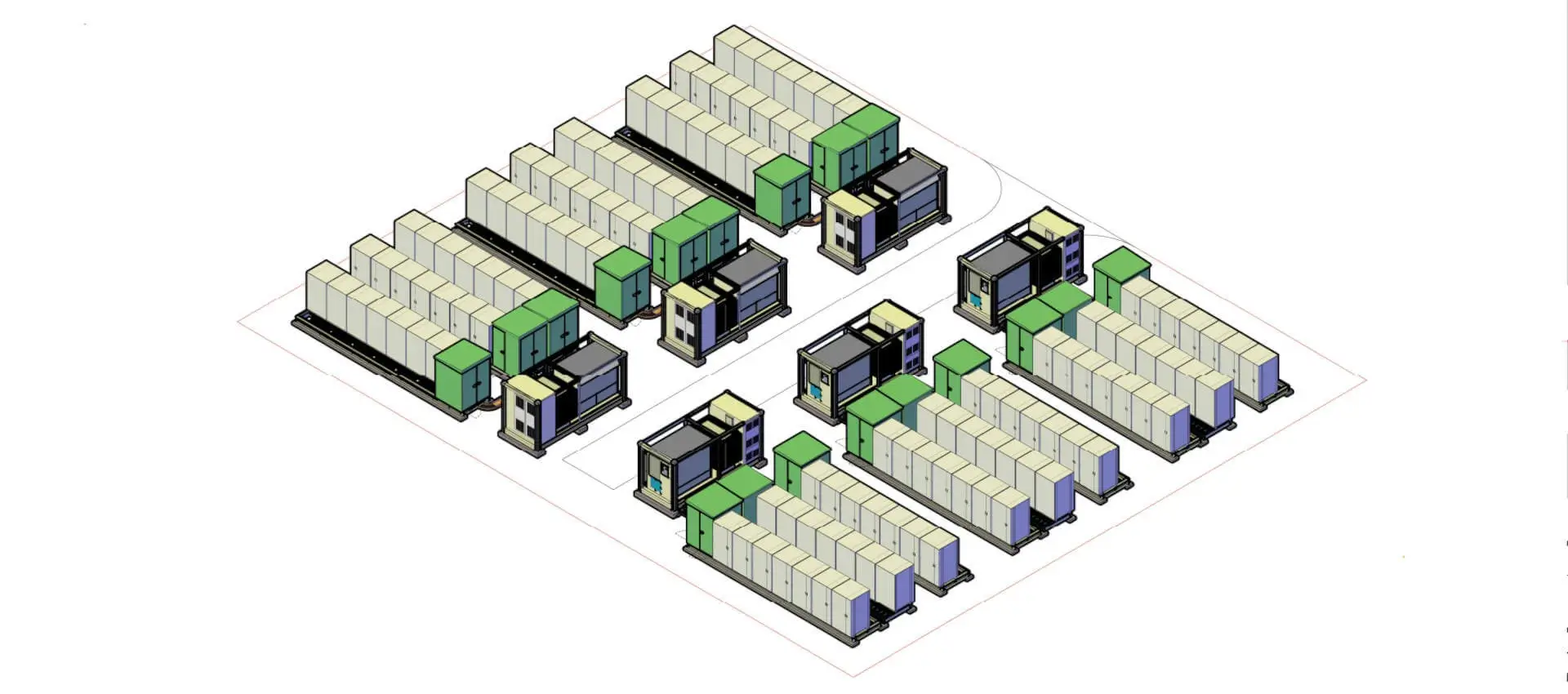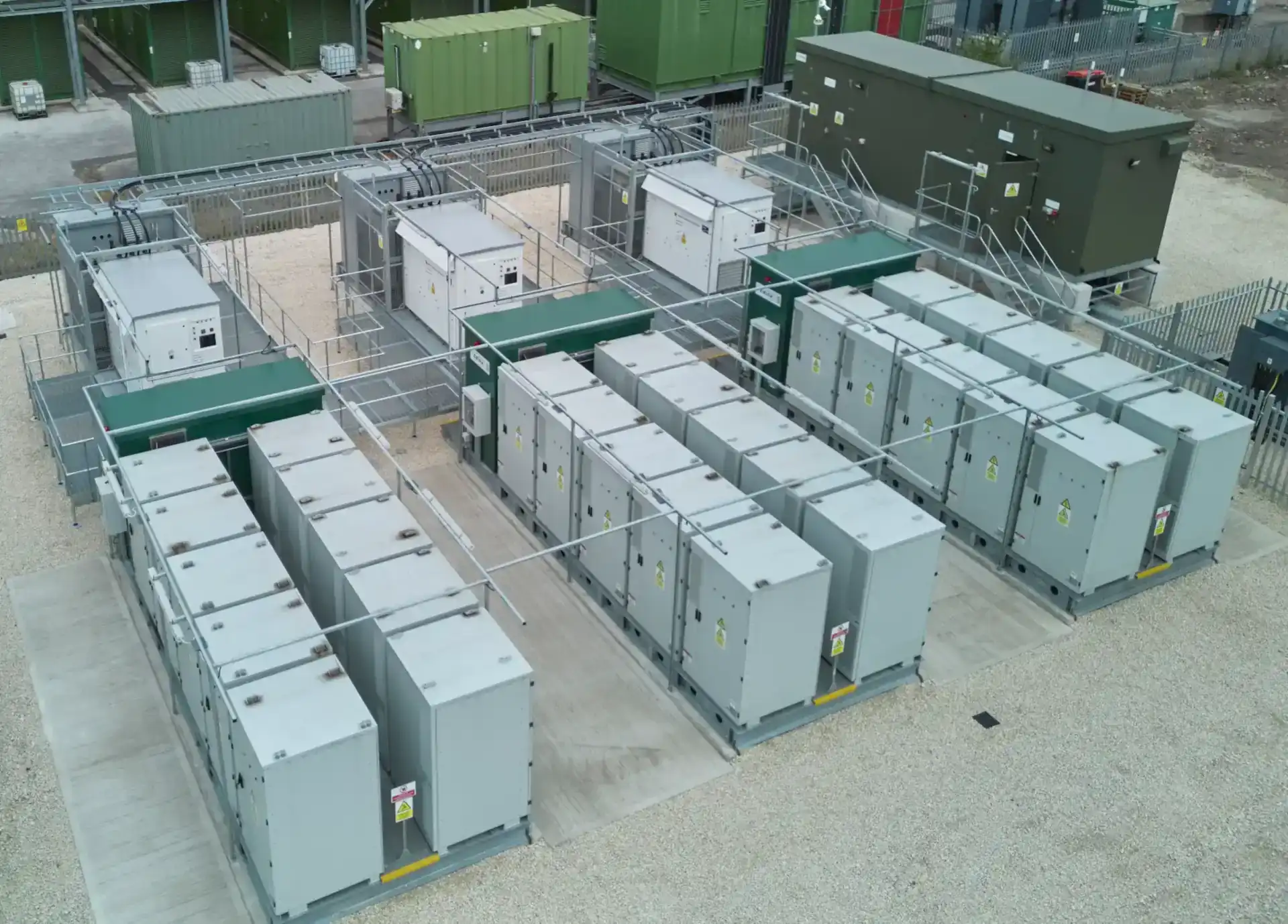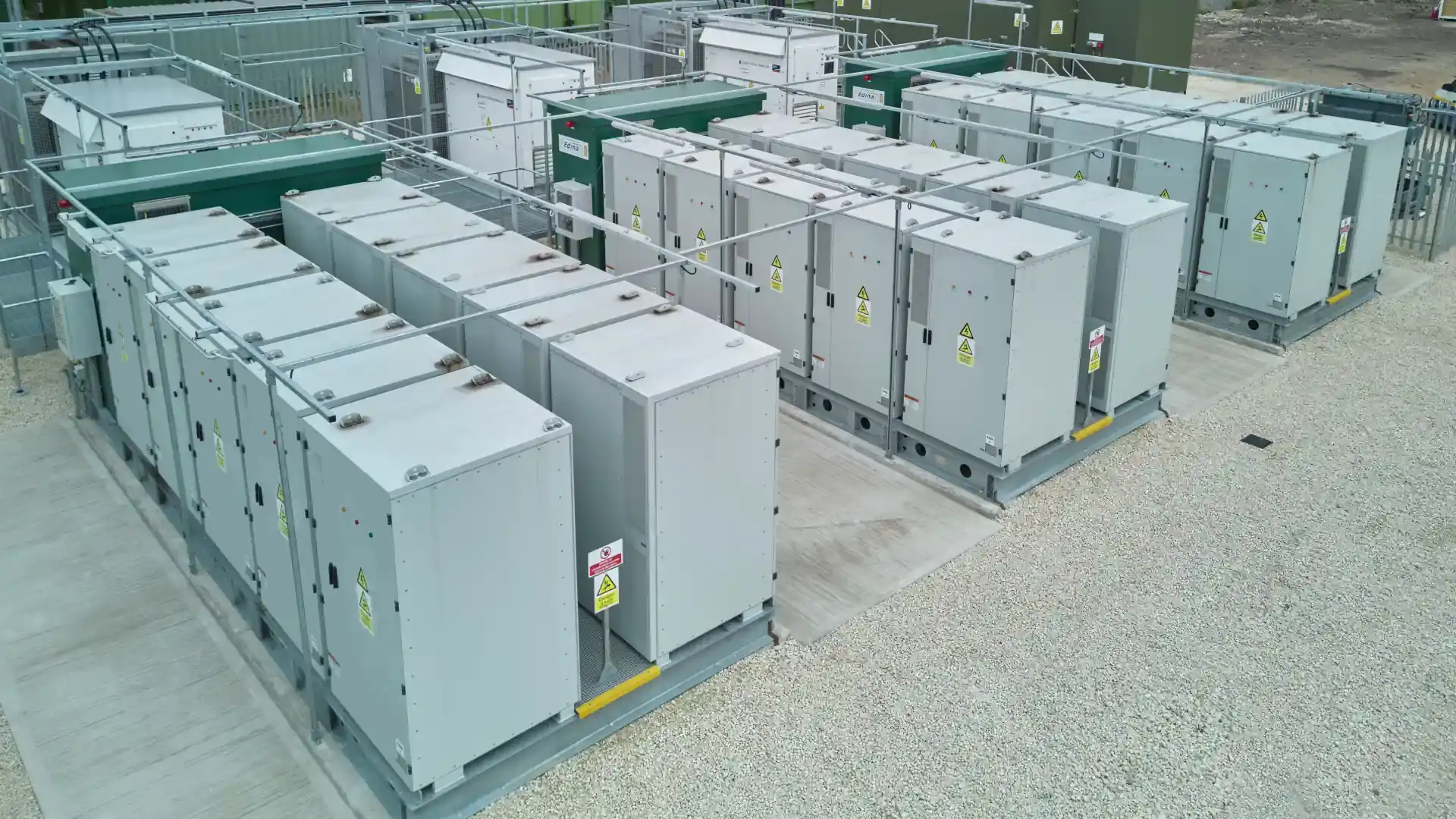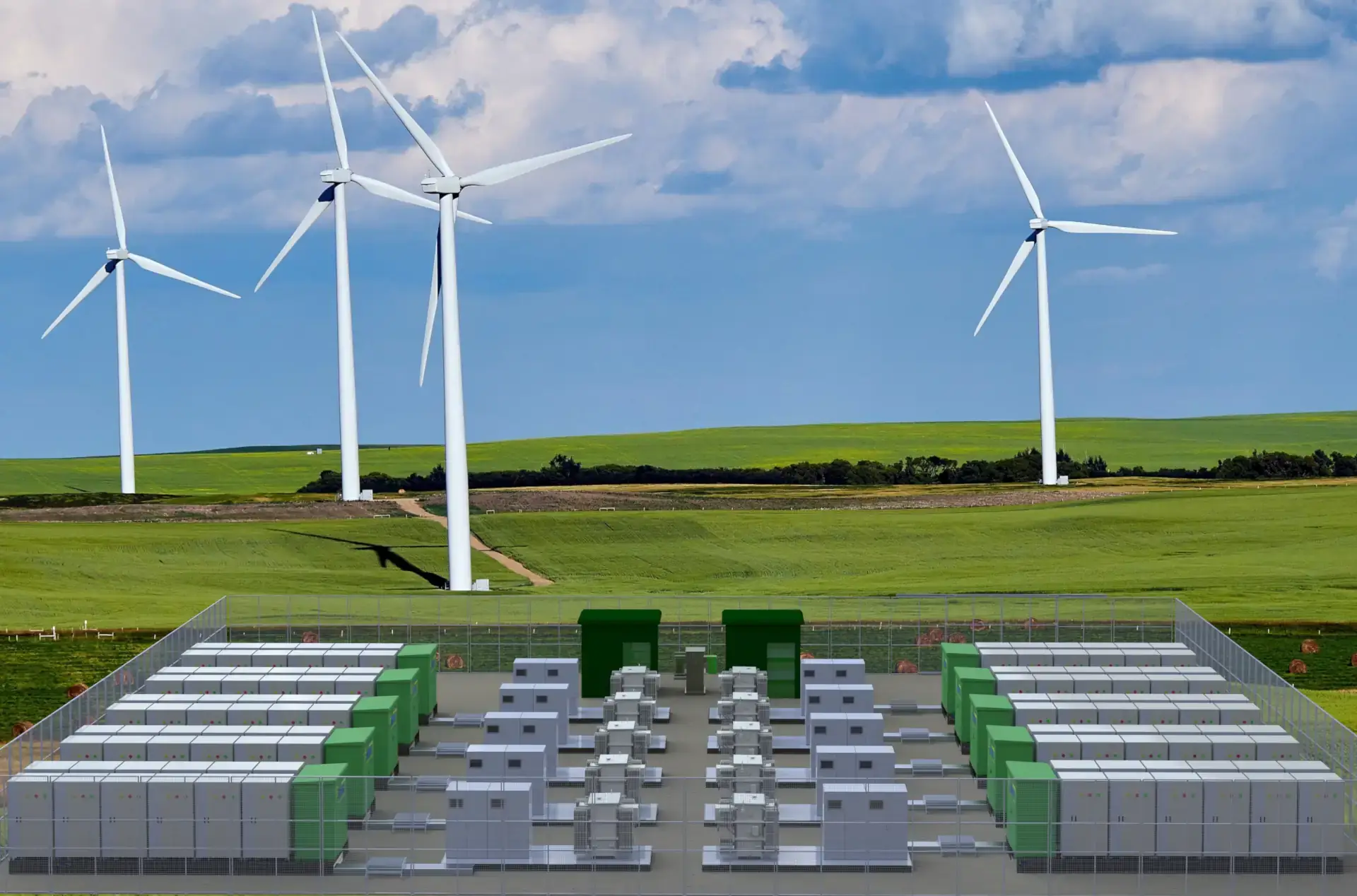
A battery energy storage system (BESS) captures energy from renewable and non-renewable sources and stores it in rechargeable batteries (storage devices) for later use.
A battery is a Direct Current (DC) device and when needed, the electrochemical energy is discharged from the battery to meet electrical demand to reduce any imbalance between energy demand and energy generation.
The increase in renewable energy sources and drive to achieve net zero carbon make BESS an essential technology for commercial and industrial organisations. By adopting BESS, it can provide a vital pathway in the transition to green energy and accelerate your journey towards net zero.
A BESS collects energy from renewable energy sources, such as wind and or solar panels or from the electricity network and stores the energy using battery storage technology. The batteries discharge to release energy when necessary, such as during peak demands, power outages, or grid balancing. In addition to the batteries, BESS requires additional components that allow the system to be connected to an electrical network.
A bidirectional inverter or power conversion system (PCS) is the main device that converts power between the DC battery terminals and the AC line voltage and allows for power to flow both ways to charge and discharge the battery. The other primary element of a BESS is an energy management system (EMS) to coordinate the control and operation of all components in the system.
For a battery energy storage system to be intelligently designed, both power in megawatt (MW) or kilowatt (kW) and energy in megawatt-hour (MWh) or kilowatt-hour (kWh) ratings need to be specified.
The power-to-energy ratio is normally higher in situations where a large amount of energy is required to be discharged within a short time period such as within frequency regulation applications. For pricing purposes, however, the quoted measure is usually the energy rating.
A battery’s C rating is the rate at which a battery can be fully charged or discharged. For example, charging at a C-rate of 1C means that the battery is charged from 0 - 100% or discharged from 100 - 0% in one hour.
A C-rate higher than 1C means a faster charge or discharge, for example, a 2C rate is twice as fast (30 minutes to full charge or discharge). Likewise, a lower C-rate means a slower charge or discharge, as an example, a C-rate of 0.25 would mean a 4-hour charge or discharge.
The formula is:
T = Time
Cr = C-Rate
T = 1 / Cr (to view in hours), or T = 60 min / Cr (to view in minutes). For example:
| C-Rate | Time |
| 2C | 30 minutes |
| 1C | 1 hour |
| 0.5C | 2 hours |
| 0.25C | 4 hours |

Battery storage systems have several advantages when paired with renewable energy and non-renewable forms of generation. Solar and wind can be unpredictable, so battery storage systems are a key component in steadying energy flow by providing a steady supply whenever required, irrespective of weather conditions. Additionally, BESS can protect users from potential supply interruptions that could threaten the energy supply. Here are some of the benefits of battery storage systems:
Installing a battery energy storage system powered by renewable energy generation technologies helps reduce carbon emissions from fossil fuels and contributes to the net zero pathways in combatting the effects of global warming.
BESS allows consumers to store low-cost solar energy and discharge it when the cost of electricity is expensive. In doing so, it allows businesses to avoid higher tariff charges, reduce operational costs and save on their electricity bills.
Battery storage systems guarantee a continuous energy supply, even at times when the network is unstable due to peaks in demand or extreme weather events.
The sun is not always “on.” A battery storage system works round the clock and therefore compensates for any fluctuations in solar energy supply by storing any excess energy and maximise renewable energy generation.
A full battery energy storage system can provide backup power in the event of an outage, guaranteeing business continuity.
Battery systems can co-locate solar photovoltaic, wind turbines, and gas generation technologies. In doing so, BESS co-location can maximise land use and improve efficiency, share infrastructure expenditure, balance generation intermittency, lower costs, and maximise the national grid and capacity.
The battery energy storage system can regulate the frequency in the network by ensuring it is within an appropriate range. Discrepancies between generated and required energy can cause short-term problems, such as outages or blackouts, but BESS can quickly react and secure sub-second frequency response, stabilising the network. Additionally, it guarantees voltage stability by keeping it within established boundaries.
In summary:
BESS solutions include these core components:
Battery System or Battery modules – containing individual low voltage battery cells arranged in racks within either a module or container enclosure. The battery cell converts chemical energy into electrical energy. The batteries are connected in series and parallel for the required capacity.
Storage enclosure - either as an outdoor module or containerised solution along with thermal management.
Battery Management System (BMS) – which ensures the battery cell's safe working operation, ensuring it operates within the correct charging and discharging parameters. In doing so, the BMS monitors the battery cell's current, voltage, and temperature and estimates its state of charge (SoC) and State-of-Health (SoH) to prevent safety risks and ensure reliable operation and performance.
Inverter or a Power Conversion System (PCS) – the battery cell produces direct current (DC), which the PCS converts into alternating current (AC) used for the power grid, commercial or industrial applications. Bidirectional inverters allow for the charging and discharging of the battery cell.
Energy Management System (EMS) – controls and monitors the energy flow of the BESS and systems. The EMS coordinates the BMS, inverters and other components of the battery energy system by collecting and analysing data used to manage and optimise the overall system performance.
Safety Systems – subject to system functionality and operating conditions, a BESS will include fire suppression, smoke detection, a temperature control system, and cooling, heating, and air conditioning systems. A dedicated monitoring and control system will ensure the safe operation of the BESS and the prevention of fire and hazardous incidents. The BESS will also be housed within a secure restricted access area and include CCTV monitoring.

Rated Power Capacity is the total discharge capability (usually in megawatts (MW)) or the maximum rate of discharge the BESS can achieve, starting from a fully charged state.
Rated Energy Storage Capacity is the total amount of stored energy in kilowatt-hours (KWh) or megawatt-hours (MWh). Capacity expressed in ampere-hours (100Ah@12V for example).
The amount of time storage can discharge at its power capacity before exhausting its battery energy storage capacity. For example, a battery with 1MW of power capacity and 6MWh of usable energy capacity will have a storage duration of six hours.
Depth of Discharge (DoD) expresses the total amount of capacity that has been used.
The amount of time or cycles a battery storage system can provide regular charging and discharge before failure or significant degradation. Cycle Life is the number of times a battery storage part can be charged and discharged before failure, often affected by Depth of Discharge (DoD), for example, one thousand cycles at a DoD of 80%.
Self-discharge occurs when the battery's stored charge (or energy) is reduced through internal chemical reactions or without being discharged from performing work for a customer or the grid. Self-discharge is usually expressed as a percentage of the charge lost over a certain period. It is an essential parameter in batteries intended for longer-duration applications.
Discharge Rate (C) describes the current that a battery can deliver for a period of time, as an example, C5 is the current a battery will provide over 5 hours to reach full discharge.
The state of charge is usually expressed as a percentage representing the battery's present charge level and ranges from wholly discharged to fully charged. The state of charge influences a battery's ability to provide energy or ancillary services to the network at any given time. The state of Charge expresses the amount of capacity remaining.
Round-trip efficiency is the ratio of energy charged to the battery to the energy discharged from the battery and is measured as a percentage. It can represent the battery system's total AC-AC or DC-DC efficiency, including losses from self-discharge and other electrical losses.
In addition to the above battery characteristics, BESS have other features that describe its performance.
The ramp rate is the rate at which the BESS may decrease or increase its power output - ramp down or up, respectively.
The response time is when BESS must move from the idle state and start working at full power.
Lithium iron phosphate (LFP) and lithium nickel manganese cobalt oxide (NMC) are the two most common and popular Li-ion battery chemistries for battery energy applications. Li-ion batteries are small, lightweight and have a high capacity and energy density, requiring minimal maintenance and provide a long lifespan. Lithium-ion batteries can also be rapidly charged and have a low self-discharge rate.
The disadvantages of this battery technology include excessive cost, inflammability, intolerance to extreme temperatures, overcharge, and over-discharge.
Lead-Acid batteries are well-proven within the automotive industry and behind-the-meter grid and UPS applications. PbA batteries are widely available, low cost, widely recyclable, and can perform effectively at both hot and cold temperatures. However, due to advances in Li-ion battery technology, lead-acid batteries have a low energy density and are slow to charge.
A sodium-sulphur battery is a molten salt-based device. Na-S batteries have several advantages, including high energy and power density, a long lifespan, and reliable operation under extreme 300 to 350 degrees Celsius temperatures. However, this battery technology is primarily suited to large-scale stationary grid storage applications due to high operating temperatures and corrosion sensitivity. Sodium is also a dangerous component because it is highly flammable and potentially explosive.
Flow batteries store energy in liquid electrolyte solutions, unlike traditional rechargeable battery solid electrode material. The vanadium redox battery (VRB) is the most prevalent flow battery type and is suitable for longer durations of up to 8 hours or where an extended lifetime is required. Despite their low energy capacity and charge/discharge rate, flow batteries respond quickly and reduce fire risk due to the non-flammable electrolytes used.
A zinc-bromine battery is a rechargeable battery that uses the reaction between bromine and zinc metal to produce an electric current with an electrolyte composed of an aqueous solution of zinc bromide. The zinc-bromine battery was developed as an alternative to lithium-ion batteries for stationary power applications from grid-scale to domestic scale. The water-based electrolyte in Zinc-bromine batteries makes the battery system less prone to fire and overheating than lithium-ion batteries.

Battery energy storage can be beneficial for several reasons due to the flexibility of co-locating with other renewable energy sources or non-renewable sources. Battery energy storage also requires a relatively small footprint and is not constrained by geographical location. Let’s consider the below applications and the challenges battery energy storage can solve.
A battery energy storage system can balance loads between on-peak and off-peak periods. The electricity demand fluctuates depending on the day of the week, time of day, and seasonality. As such, when there is peak electrical demand, prices are at their most expensive. Alternatively, the power price is at the standard rate when demand is low during off-peak periods. Peak shaving allows users with battery energy storage systems the assets to store power during off-peak periods and discharge during peak times to reduce electricity costs.
Energy time shifting or arbitrage allows users with BESS solutions to store their purchased power during off-peak times to use on-site when the imported power price is high. Alternatively, users can trade their stored electricity via the flexibility markets (Energy Markets, Ancillary Services, and Capacity Market) for income generation.
Battery energy storage can supply fast response backup power in the event of a mains failure to ensure infrastructure is operational and downtime is minimal. Using these battery energy storage systems alongside power generation technologies such as gas-fired Combined Heat and Power (CHP), standby diesel generation, and UPS systems will provide increased resilience mitigating a potential loss of operational costs, whilst protecting your brand.
A BESS has a frequency response which allows it to provide active power output when there is a change in the electrical grid's frequency. A deviation from the nominal frequency indicates a mismatch between power supply and demand, which can destabilise the grid, causing outages or blackouts. To restore balance quickly, the BESS can adjust its active power output by reacting to deliver sub-second frequency response to stablise and balance supply and demand within the network. The growing share of renewable generation and decentralised power plants connected to the network, means battery storage will continue to play a critical role in our energy transition.
In Front-of-the-Meter (FtM) applications battery storage systems are typically referred to as utility or grid-scale battery storage and can be connected to transmission or distribution networks to reduce congestion management whilst also controlling voltage and providing reserve and ancillary services. A BESS can also support power generation assets.
BESS are typically Behind-the-Meter (BtM), and applications include avoiding electricity network charges, benefiting from tariff differences, delivering value-added balancing services, or enhancing on-site resilience and energy consumption when paired with on-site solar PV, thus saving money and optimising the sustainability benefits.
BESS can be paired with other renewable and non-renewable technologies to form a hybrid power solution. For example, these hybrid systems can enhance the performance of new and existing gas engine installations. Combining a battery storage system with gas generation and solar power will go a long way to making cheaper, cleaner and more reliable power more accessible.
BESS projects can be attractive by obtaining ‘stacked’ revenue streams. These include:
Participants may earn revenue for entering into commitments under a statutory contract called a ‘Capacity Agreement’ with the Government. These Capacity Agreements provide a backup electricity supply to meet peak demand during system stress. The agreements may have a duration of up to 15 years.
These agreements are with the consumers for a negotiated price. The contracts are known as Power Purchase Agreements or PPA. PPAs may have a duration of up to 15 years.
Dynamic Frequency Response provides an extremely valuable source of income. However, contracts with the National Grid typically have two years. Under the dynamic frequency response contracts, the operator responds to fluctuations in demand on the network by reducing or increasing its energy consumption. This is organised through the Dynamic Containment Service.
Users with BESS assets can optimise their energy usage to lower costs, improve sustainability or reduce costs. Electricity can be purchased and stored when prices are cheap and discharged during peak times to offset energy costs.
The main driver for battery storage in Ireland is the DS3 (Delivering a Secure Sustainable Electricity System) programme, which was brought in to enable Ireland to meet its 2020 renewable energy targets and to manage the increased amount of renewable generation connected to the grid.
The DS3 programme allows the system operator to procure ancillary services, including frequency response and reserve services; the sub-second response needed means that batteries are well placed to provide these services.

Most energy systems have a varying demand with some short-term but significant peak power requirements, which results in a capacity requirement which might only be used for a fraction of the time. Energy storage enables energy to be saved for later use.
Energy storage creates capabilities and efficiencies low cost energy for the electric grid and assists in mitigating climate change.
Renewable energies are intermittent in nature, i.e., their capacities to produce energy vary with time. Energy storage from renewable energies can avoid any curtailment of renewable energies during favourable weather conditions when excess wind or solar energy gets generated.
The UK government estimates that technologies like batteries will form part of the UK’s smarter electricity grid, heat and transport technologies, supporting the integration of more low-carbon power, could save the UK energy system up to £40 billion by 2050.
Aside from battery energy storage systems, other energy storage technologies include:
During periods of low electricity demand, surplus generation is used to pump water from a low-elevation reservoir up to a high-level elevation. When water is released from the high-level elevation, it flows down through a turbine to generate electricity to meet peak demand.
Electricity is used to compress ambient air, which is stored under pressure in underground caverns or containers. When electricity demand is high, the pressurised air is heated and released into an expansion turbine generator for power production.
It is a way by which mechanical energy may be stored in the form of potential or kinetic energy. Electric motors accelerate a flywheel at high speeds through which the energy is stored as kinetic rotational energy. When there is an electricity demand, the spinning force of the flywheel is connected to a generator to produce power.
Electricity may produce thermal energy, which can be stored until needed. For example, electricity can be used to make chilled water during low demand and later used for cooling during peak electricity consumption. The UK's gas system distributes about twice as much energy as electricity, and this energy is used for heating. Heating demands vary with season and time of day, and thermal energy storage can load shift and smooth demand on the plant. Move heat from the summer to the winter.

Are you looking to deploy Battery Energy Storage Systems? We are a BESS turnkey EPC contractor and systems integrator of advanced global Tier 1 battery and inverter technologies to provide an industry-leading battery energy storage solution that is scalable and delivers guaranteed performance.




Copyright © Edina. All Rights Reserved.